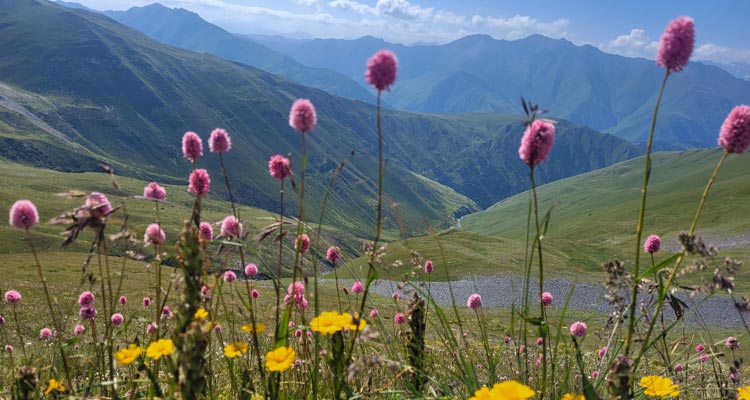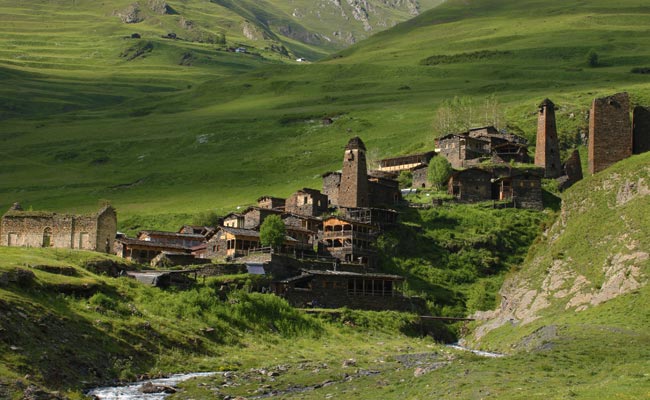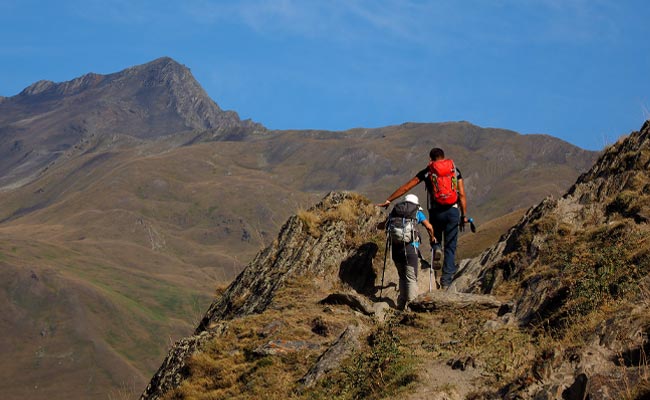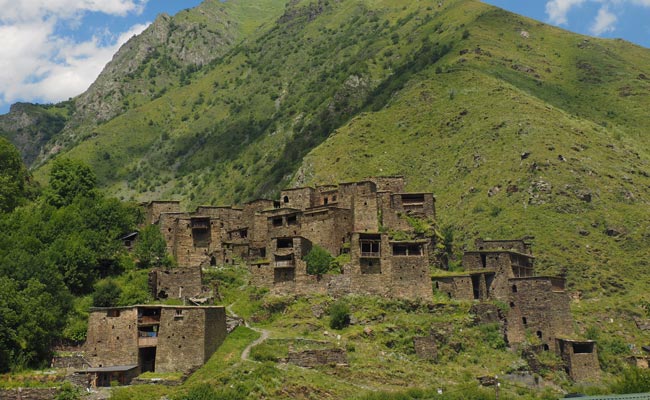|
Khevsureti Khevsureti is a scenically wild region in the north of Georgia, with numerous fortified towers, fortified villages, wild rivers, steep Rocky Mountains, large mountain lakes and many hiking trails. Khevsureti is also a difficult area to get to, its administrative centre is 150 kilometres from Tbilisi, but it takes about 5 hours to get there in a good 4x4, and only in the summer as the road is closed in the winter. However, Khevsureti is well worth the time and effort, especially the fortified villages of Shatili and Mutso, and the mountain lakes of Abudelauri, which are among the highlights of Georgia. General info Surface area: 1,036 km2 The name The region owes its name to its mountainous geography, with steep slopes and deep gorges, because "Khevi" in Georgian means gorge and the name Khevsureti means something like "land of gorges". However, the region was first mentioned under this name at the end of the 15th century. The historical name of Khevsureti, together with the neighbouring region of Pshavi, is "Pkhovi". History of Khevsureti The territory of present-day Khevsureti was inhabited as early as the Bronze Age, as evidenced by numerous archaeological finds. The inhabitants of the region were considered to be a militant and freedom-loving people, and they attracted attention as early as the 1st century BC. When the Roman general Pompey conquered parts of eastern Georgia, he tried to advance into the north of the country, but the inhabitants of Chewsuretia and Pschawi, then known as "Pchowi", did not allow him to do so. The next written mention of the area, which continued to be called "Pchovi", dates back to the 4th century. At that time, Georgia had recognised Christianity as the official state religion, and Georgian kings also tried to convert the mountain regions of the country, but it was not so easy to convince people in the mountains of the new religion, so many from Pchovi fled to neighbouring regions, especially to Tusheti. The Georgian kings were aware of the important role played by the inhabitants of Khevsureti as the country's border guards, and they always tried to maintain good relations with them. In this sense, they were largely exempt from taxes and were directly subordinate to the king. However, the inhabitants of the borderlands were not only responsible for guarding the border, but also provided troops for the kings when necessary. The harmonious relationship between the royal family and the mountain people suffered at the beginning of the 13th century, during the reign of Queen Tamara, when the people of Pkhovi rebelled against their own government. It took three months for Queen Tamara's armies to bring the rebels to heel. The division of historical Pkhovi into two distinct regions, Pchavi and Khevsureti, should date from this period, but the name Khevsuretia does not appear in Georgian sources until the 15th century, after Georgia had been divided into three separate kingdoms and the territory of Khevsuretia had been incorporated into the Kingdom of Kakheti. In the following centuries, Khevsureti was an important base for the East Georgian kings, especially during the reign of Irakli II. After fraternising with the Khevsurs and personally baptising 50 local children as a sign of goodwill, the king won the hearts of the mountain people forever, and they were always on his side when he needed them. The Khevsurs fought bravely alongside King Irakli at the battles of Aspindsa in 1770 and Krzanissi in 1795. After the annexation of Georgia by Russia in 1801, Khevsurians led by Prince Alexander, son of the late King Erekle II, rebelled against Russian troops several times, but the outnumbered Khevsurians were finally defeated in 1830. The inhabitants of Khevsureti could not get used to the Soviet regime, especially the forced collectivisation, and often rebelled, which is why the Soviet regime carried out a "planned resettlement" in the region in 1953, as a result of which most of the Khevsureti settlements were emptied. It is interesting to know that the construction of roads in Khevsureti started only in 1930 and the first car reached the region on 25 November 1934. There were also plans to extend the road to Chechnya, but the project was never realised. Since the 1980s, the Soviet and then Georgian governments have pursued a policy of increasing the permanent population of the region. Villages are also being rehabilitated and, from 2019, the connecting road over the 2,677-metre Datvidzvari Pass will be upgraded. Cultural and Natural Highlights Khewsureti is rich in natural and cultural attractions. There are unique fortified villages built on steep slopes and numerous fortified towers, which are very different from those in Svaneti in terms of shape, building materials and sometimes even function. Also of interest are the slate shrines, which have not lost their relevance in the 21st century, and the death houses, whose history is both fascinating and frightening. The landscape here is wild, the mountain slopes steep and the passes higher than average, but the reward is a fascinating mountain scenery rarely seen elsewhere. Cultural Highlights 1. Fortified village of Shatili Natural Highlights 1. The mountain lakes of Abudelauri Traditions and folk festivals in Khevsureti Just like in the neighbouring region of Tusheti, traditions and folk festivals in Khevsureti have changed to some extent and new ones have been added after the inhabitants were resettled in the valley in the 20th century, but several festivals, especially religious ones, have not lost their character and are still lived on in the 21st century. 1. Atengenoba - similar to the festival Atnigenoba in Tusheti, the festival in Khevsureti takes place 100 days after Easter. It is the most important festival in the region and is held at every house of prayer (Dzhvari) if possible. The procedure: Two weeks before the festival, the "servants of the House of Prayer" go to the House of Prayer to purify themselves and prepare for the festival. This includes brewing holy beer and preparing the sacrifice. Early in the morning on the day of the festival, a special liturgy is conducted by the "Khutsesi" - elder, then the prepared offering is sacrificed according to the rite, and only then can the people participating in the festival come to the prayer house themselves, light candles and make their offering in the form of a lame, regional dishes, etc. With the traditional rituals and offerings, people try to earn God's protection and also owe themselves to Him. 2. Shatiloba - Shatili is the administrative centre of Khevsureti and every year at the end of August or the beginning of September a folk festival is held there with traditional dances, songs, competitions, horse races, etc. There are also stalls selling handmade traditional items. Shatiloba is very popular in Georgia, and on this day, along with ordinary citizens, government leaders often come to Shatili. 3. Mtis Festivali - Festival of the Mountains, usually held at the end of August in various villages of Khewsureti, but also in villages of other regions. The purpose of the festival is to revive the villages, which are sometimes empty, and to make them known throughout the country. Concerts are held in each village; famous personalities are invited and competitions are organised. Shrines and common religious rituals in Khevsureti The inhabitants of Khevsureti, like most Georgians, are Christian, but .... According to local beliefs and oral tradition, in the past the regions of Khevsureti were largely inhabited by evil spirits and God created two idols, "Kopala" and "Jakhsari". He instructed them to rid these areas of evil spirits, and only when the work was done could the people live in peace. "Kopala" and "Yaksari", together with other idols, were for a long time very important religious figures, and still are to some extent, but several centuries after the Christianisation of Georgia, male idols were replaced by St George and female idols by the Virgin Mary. The pagan rituals live on, however, and apart from the Christian names and the lit candles, there is little that is orthodox about the traditional services of the people in Khevsureti. For example, according to local tradition, the liturgy is not celebrated in the church but at the "dzhvari" and "khati", which are prayer shrines about two metres high, built of natural stone, usually decorated with ibex horns and often with a small bell attached. The most important prayer houses of the Khevsuren are Gudanis Dzhvari, Anatoris Dzhvari and Karatis Dzhvari. The liturgy is also not performed by a priest, but by a village elder who is elected by the village. The liturgy itself has little to do with the canonised Orthodox services, which are more like an offering in the form of an animal, or dishes specially prepared for the day. During the offering, a special prayer is said for the saint to whom the shrine, sanctuary, etc. is dedicated. Another important factor that distinguishes the local faith from the Christian faith is the prohibition for women to approach a prayer shrine. This may sound very unusual to many visitors to the region, but as a guest you simply have to accept it. The faith, prayer houses and religious rites in Khevsureti are very similar to those in the neighbouring region of Tusheti, except that in Khevsureti not only prayer shrines themselves are sacred, but also relatively large areas around the shrine, where nothing may be planted or built. Traditional Clothing Khevureti is well known for its particularly elaborate hand-embroidered costumes called "talavari". They are shorter than other Georgian costumes and have no buttons. They are embroidered with traditional Georgian and geometric ornaments, mostly crosses in various braided shapes. Women's talavari are also decorated with beads. Until the mid-20th century, Khevsurians wore their national costumes in everyday life, but nowadays they are only worn at festivals. The cuisine Due to the steep mountains and deep gorges, Khevureti has less arable land and fewer opportunities for animal husbandry than other regions of Georgia. This also affects the cuisine, which is why the specialities of Khevureti, although very tasty, are less varied than in many other areas of the country. 1. Khevsuruli khinkali - Khevsuretian-style stuffed dumplings. Khinkali is made in every mountain region of Georgia, but everyone makes it a little differently. In Khevsureti, in addition to meat, the dumplings are also filled with cheese, cottage cheese or potatoes. 2. Khavitsi - Tastes similar to fondue and is also prepared in Tusheti, as well as in other mountainous regions of Georgia. It is a heated, liquid mixture of curd-like hard cheese, clarified butter and salt. The most common alcoholic beverages in the region are homemade beer and fruit brandy. Hiking routes in Khevsureti There are numerous hiking routes in Khevsureti, but most of them are not classified as easy, but rather as medium to very difficult. However, if you are physically fit and have the appropriate clothing and equipment, everything is less complicated. The best thing about hiking in Khevsureti is that you are usually at a relatively high altitude, along the ridge, and the views are correspondingly beautiful. The hiking areas in Khevsureti are not very well developed and there are few signs, but you won't meet too many other hikers. What is special about the region is that Khevsureti is mostly used as a transit area, and from there you can either walk to Tusheti or towards Stepanzminda. Here are some particularly attractive routes from Khevsureti 1. from Roshka via the Abudelaueri Lakes and the Tchaukhi Pass to Djuta (day hike). How to get to Khevsureti The bus to Khevsureti leaves Tbilisi twice a week, on Wednesdays and Saturdays at 9am, from Didube bus station in the direction of Shatili. The trip to Shatili takes about 5 hours and costs 30 Lari per person. (2023).
Trekking from Omalo to Shatili >> from 990 EUR
|






